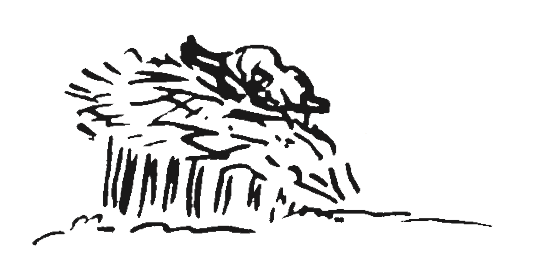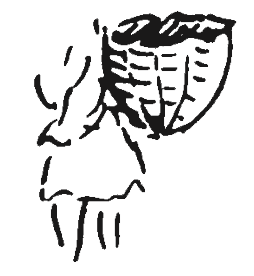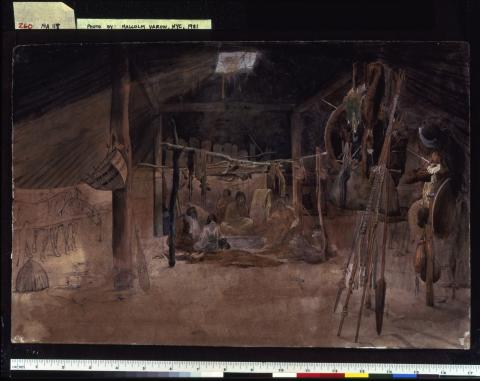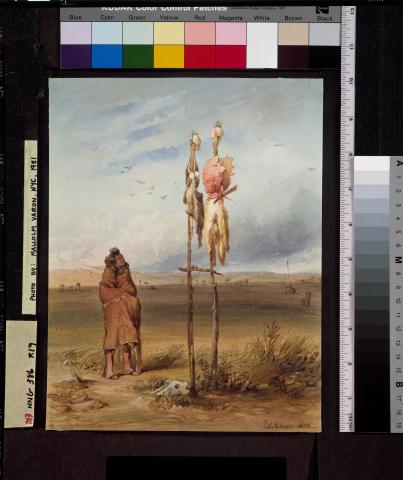November 15, 1833
15 November In the morning, the sky slightly overcast; freezing; hoarfrost. Wing moderately strong, west hora 7 north. The Missouri carried ice for the first time; the sandbars were covered with a thick bank of ice. At seven thirty, 22 1/2°F [−5.3°C]. After nine o'clock, the wind got a bit stronger.
The father-in-law of Mr. Kipp, Mandeck-Suck-ChoppeníhM7'n' as in French, 'ch' velar, last 'e' articulated half. (Medicine Bird),M8L'Oiseau de Medecine [marginal note] [Ed.: The modern orthography for this name, which Maximilian also spelled with no accents, is Warek Suk Xopri.] came early and brought along a wife. He is a man of about fifty years and is very well informed in everything as far as his nation is concerned. He [was to] be questioned many times. Even though the river was open, no more waterfowl had been seen for a considerable time; they had all moved away.
Today Mr. Kipp, with many people, took my boat out of the river to save it from the ice. About ten o'clock the sun appeared; the weather turned pleasant. Dreidoppel went out with the gun. About noon the weather was extraordinarily beautiful and rather calm. I went out and followed the creek that ran up behind the fort, collected Solidago seeds, and found several types of grass that I took along dry. In shrubs of dry Syngenesia, a flock of Fringilla linaria americana stayed, the first birds I had seen on the prairie up to now. The Mandan women moved continuously across the creek with loaded horses and dogs, following the path they had made to get to their forest. They always had large dogs with them.
[Returning to] the fort I found several Indians whom I had not [previously] seen, among them, one with large brass rings in his ears and a large bear claw on his wrist, which was medicine for him. Women with Indian corn came to trade. This grain had very nice colors. I often went to the creek, where they say one [can] find ducks often in spring. Here and there its banks were washed out, kettlelike and collapsed. The Indians have laid out little squash fields in places in the small ravine where [this creek] flows.  Fox traps are often [set there]. The sides are covered with wood [sticks]; a heavy stone strikes the animal dead. [The traps are] covered with brushwood; frequently there is an old buffalo head lying on [top]. In these traps, [a great] many of the smallprairie fox, also called kit-fox, are caught in winter. Their burrows may be found everywhere on the prairie.
Fox traps are often [set there]. The sides are covered with wood [sticks]; a heavy stone strikes the animal dead. [The traps are] covered with brushwood; frequently there is an old buffalo head lying on [top]. In these traps, [a great] many of the smallprairie fox, also called kit-fox, are caught in winter. Their burrows may be found everywhere on the prairie.
Dreidoppel returned in the afternoon. He had seen many prairie hens without being able to shoot any. At twelve o’clock, 40 1/4°F [4.6°C]. Mr. Kipp brought his lighter on land beside my boat. He had hit a white rabbitM9Lepus veriabilis. [marginal note] [Ed.: Likely L. townsendii, white-tailed jackrabbit.] but did not get it. Mr. Bodmer went drawing and saw a duck (Anas boschas) on the Missouri. I went out once again and shot a few Fringilla linaria.M10I received the same bird from Greenland, where it nests in summer. It flies south in winter; in the fall they were everywhere on the upper Missouri in small flocks of ten to twenty. [Ed.: Maximilian's natural history collections at his home in Neuwied included speciments sent to him for numerous locations around the world by specific colleagues.] After one o’clock Mató-Tópe came with his wife and child. He was wearing a blue and red uniform. Attached to his shoulders and arms were strips [embroidered with] white glass beads, in the Indian fashion. All along his arms there were fringes of black human hair. His face was painted yellow; the rims of his eyes were red, as well as the upper part of his forehead. He usually wore his hair in two short, thick cadogans tied off with a red ribbon; a red-colored feather was stuck upright behind the crown [of his head]. He wore the uniform on his bare body, tied [together] in front with a small leather strap.
In the afternoon I went with Mr. Bodmer to the area of the graves or scaffolds, about 300 paces from the fort, and he sketched a few medicines, among them the buffalo skulls and human skulls I mentioned a short time ago, lined up between four poles. The village was in the distant [background]. There were [other], different medicines [that] I describe further on. Afterward we looked at the graves nearby. Many [had] small boxes [placed] on scaffolds of four poles, in which, without doubt, children lay. Some of these were bound with hides and partially painted parflèche hides. On other scaffolds we saw skulls protruding from the hides, completely bleached. [On] still others, all the bones were attached together or hanging down freely.  Below some medicine arrangements, brand new battle-axes lay,offered as [sacrifices]. Some of the women who walked to the winter village in the forest carried on their backs baskets or pack baskets made of hide or leather, [the interiors] kept open with sticks. Horses grazed in the prairie 800 paces from the village, sometimes kept together by a boy. We inspected the various skulls lying on the ground below the graves; I was reluctant to pick up any of them [because [Page 3:30] [of] the Indians—[we were] so close to the village. One could have easily made a highly interesting selection [of skulls] for Blumenbach’s collection, choosing very differently formed [specimens]. [In] some cases, for instance, the forehead receded very flatly, while in others it was high and strongly protruding. Some were painted with three red stripes across the skull down over the temples. I decided to commit some thefts here in the near future [to augment] the interesting collection of that learned anthropologist. For that purpose the moon [would have] to shine brightly. Mr. Kipp got his letters ready, because tomorrow he [planned to] send the people who had come with me back to the Yellowstone and another downriver to Mr. Picotte at the Yanktonais.
Below some medicine arrangements, brand new battle-axes lay,offered as [sacrifices]. Some of the women who walked to the winter village in the forest carried on their backs baskets or pack baskets made of hide or leather, [the interiors] kept open with sticks. Horses grazed in the prairie 800 paces from the village, sometimes kept together by a boy. We inspected the various skulls lying on the ground below the graves; I was reluctant to pick up any of them [because [Page 3:30] [of] the Indians—[we were] so close to the village. One could have easily made a highly interesting selection [of skulls] for Blumenbach’s collection, choosing very differently formed [specimens]. [In] some cases, for instance, the forehead receded very flatly, while in others it was high and strongly protruding. Some were painted with three red stripes across the skull down over the temples. I decided to commit some thefts here in the near future [to augment] the interesting collection of that learned anthropologist. For that purpose the moon [would have] to shine brightly. Mr. Kipp got his letters ready, because tomorrow he [planned to] send the people who had come with me back to the Yellowstone and another downriver to Mr. Picotte at the Yanktonais.I waited with my letters for the next opportunity for mailing, which can be expected any day. That evening I wrote to Mr. McKenzie and to Chardon, asking the latter to buy me some additional Indian artifacts. The afternoon was free of Indian visits.
I have to mention that a cripple was at our place earlier. He was very small, hunchbacked, with a long narrow face [but] dressed and armed with a gun, bow, and arrows like all other Mandans. A one-eyed man and a cross-eyed [or wall-eyed] Indian of the same tribe also showed up. Mr. Bodmer made a sketch of a medicine where, in the background, the last lodges of Mih-Tutta-Hangkusch can be seen. A young Indian who was with him told him that the poles with the buffalo hide and pieces of hide painted red on top were dedicated to the sun and the moon. The night was not cold initially; we already have a new moon.




